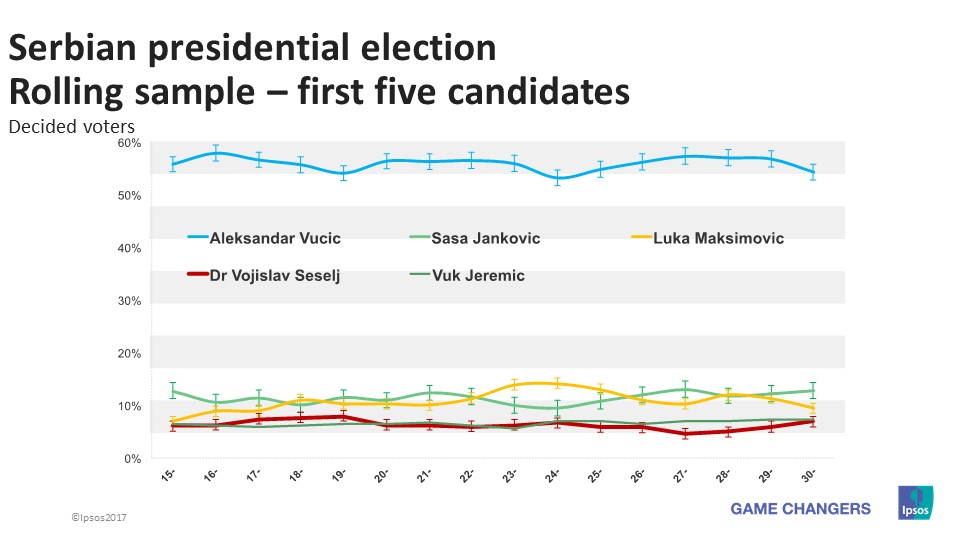Presidential Election in Serbia - Part 1: Pre-Election Surveys
Both in Serbia and in the region early elections happen very frequently – for example, in Serbia there were 22 Presidential or Parliamentary elections during the past 17 years, which resulted in very broad experience. Considering the fact that media in Serbia do not order the surveys, but political parties, Ipsos did not often happen to publicise its pre-election results, although various fake data appeared in media our name. Therefore we did not create the picture in public of really high quality of our electoral prognoses, but this fact is well known among our clients.
Exactly because of that Ipsos publicly announced its pre-election prognosis before the election held on 2nd of April, 2017, and in a number of TV and newspaper interviews Marko Uljarević, Director of Public Affairs on the level of Adria Cluster and on the level of Serbia, and Srdjan Bogosovaljević, the founder and CEO of many years standing, gave a number of interviews which were along the lines of this publicised prognosis.
|
Candidate |
Result |
Estimate in % |
Confidence interval +/- |
Bottom limit |
Upper limit |
|
Saša Janković |
16.3 |
12.8 |
1.7 |
11.1 |
14.5 |
|
Vuk Jeremić |
5.7 |
7.3 |
1.3 |
5.9 |
8.6 |
|
Miroslav Parović |
0.3 |
0.1 |
0.2 |
0.0 |
0.3 |
|
Saša Radulović |
1.4 |
1.8 |
0.7 |
1.1 |
2.5 |
|
Luka Maksimović |
9.3 |
9.5 |
1.5 |
8.0 |
11.0 |
|
Aleksandar Vučić |
55.2 |
54.3 |
2.5 |
51.8 |
56.9 |
|
Boško Obradović |
2.3 |
3.2 |
0.9 |
2.3 |
4.1 |
|
Dr Vojislav Šešelj |
4.4 |
6.8 |
1.3 |
5.6 |
8.1 |
|
Aleksandar Popović |
1.1 |
0.7 |
0.4 |
0.3 |
1.1 |
|
Milan Stamatović |
1.2 |
0.4 |
0.3 |
0.1 |
0.8 |
|
Nenad Čanak |
1.1 |
1.1 |
0.5 |
0.6 |
1.6 |
|
Invalid |
1.7 |
2.0 |
0.7 |
1.3 |
2.7 |
Out of 11 candidates exact order of all candidates was captured, 7 were within 95% of confidence interval, and all 11 within 90% of confidence interval. Ipsos was the only agency which gave the prognosis with the order that happened on election, with extremely small Mean Squared Error of the prognosis. The surveys were conducted using a mix mode and CAPI F2F, each with 500 respondents per day, and on-line with 50 respondents a day. On line part of the sample was treated as a stratum of the young, because they practically can’t be reached by other methods. Proportion of on-line participation was obtained empirically in previous surveys. The survey was conducted every day, on the basis of rolling sample which took into account the last three days. The Client was presented with 16 surveys which showed a big dynamics of changes (as much as 11 times the order was changed), as well as significant increase of turnout estimates. Data collection was finished between 8 and 9 pm, and report to the Client was sent, and very often presented around the midnight, throughout the 16 days. Before the election was called another 4 ad hoc surveys were done using the same mix mode of data collection, as well as one CATI survey and a number of focus group discussions.

The turnout was slightly overrated, and decrease in turnout compared to estimate was not proportional, due to which a small deviation occurred in case of four candidates.
The sample was a three-stage random stratified sample. Units of the first stage were selected PPS – these were local communities, units of the second stage were – households, and units of the third stage – voters, selected by simulation of simple random sampling. Weighting was done using RIM method, and among weights with lower priority was previous voting.
Ipsos is preparing a detailed mathematical-statistical analysis of the effects of using the mix-mode and its own turnout calculation formula.
The perfect results, which were not only precise, but were also accompanied by the efficiently prepared reports, were not achieved only owing to good sampling design and strict control that prevented the occurrence of non-sampling errors, but also owing to the big and well-tuned Public Affairs and Operations teams, which operated impeccably.



